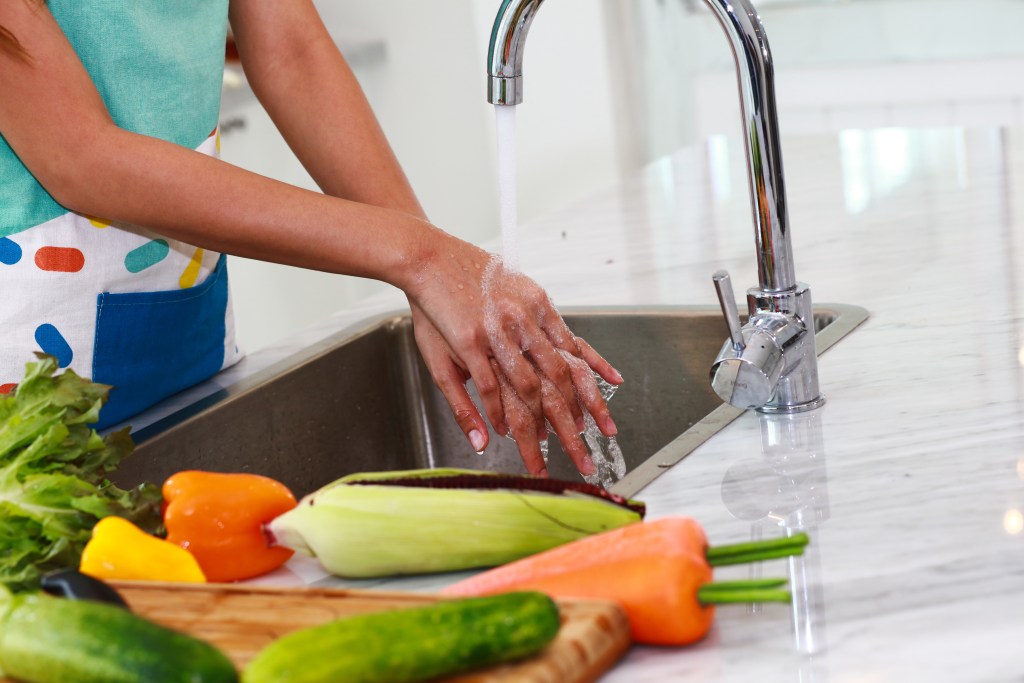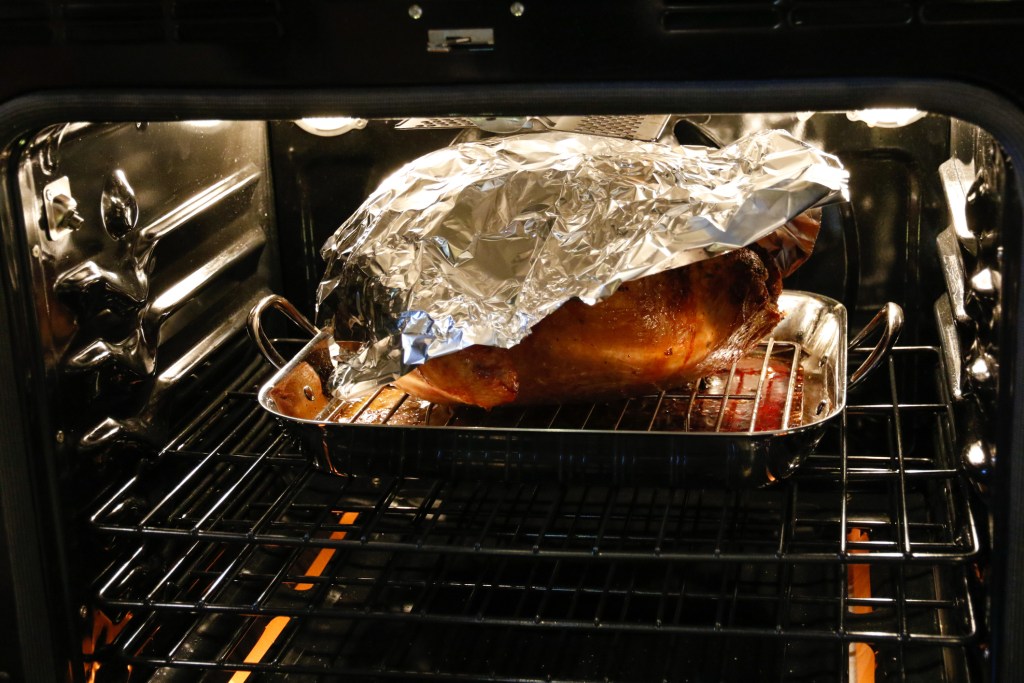The holidays are right around the corner, and it’s a great time to enjoy special meals with loved ones. Whether you’re a pro at hosting the holiday meal or this will be your very first time, it’s important to follow and practice food safety tips. Oakland County Health Division put together a helpful list of safety tips that includes cleaning, separating, cooking, and chilling your food.
- Clean: Wash your hands with soap and water before, during, and after preparing food.
- Separate: Keep meat, chicken, turkey, seafood, and eggs separate from all other foods at the grocery store and in the refrigerator. Prevent juices from dripping or leaking onto other foods by keeping them in containers or sealed plastic bags.
- Cook: Cook food thoroughly. Meat, chicken, turkey, seafood, and eggs can carry germs that cause food poisoning. Use a food thermometer to ensure these foods have been cooked to a safe internal temperature. Keep food out of the danger zone between 40°F and 140°F where bacteria can grow rapidly. After food is prepared, keep hot food hot and cold food cold.
- Chill: Refrigerate or freeze any perishable food within 2 hours.
Holiday Meal Safety Tips:
Turkey and stuffing are festive favorites, but they come with additional food safety concerns. Keep your holidays healthy by following extra precaution when preparing and serving holiday staples and don’t forget the four steps to food safety for your entire feast.

Turkey Tips
Cooking a turkey requires planning and preparation; get started using these tips from the USDA.
- Buy the turkey a few days before you plan to cook it.
- Refrain from buying a pre-stuffed turkey. USDA recommends only buying frozen pre-stuffed turkeys that display the USDA or State mark of inspection on the packaging.
- Thaw turkey in the refrigerator, in a sink of cold water (change the water every 30 minutes), or in the microwave. Avoid thawing foods on the counter. A turkey must thaw at a safe temperature to prevent harmful germs from growing rapidly.
- Remember that thawing the turkey takes 24 hours in the refrigerator for every four to five pounds, and cold water thawing takes 30 minutes per pound.
- Be sure the turkey is completely thawed before cooking.
- Set the oven temperature no lower than 325 ºF.
- Place turkey breast-side up on a flat wire rack in a shallow roasting pan 2-2 1/2 inches deep.
- Cook stuffing separately from the turkey for optimum safety.
- Check the internal temperature with a food thermometer and ensure it is at least 165 ºF.
- Let the bird sit for 20 minutes before removing stuffing and carving.
Stuffing
The Partnership for Food Safety Education has a special section devoted to stuffing in their Talking Turkey guide.
- Cook all stuffing and dressing to a minimum temperature of 165 ºF, whether it is cooked inside or outside the bird. For optimum safety, cooking your stuffing in a separate casserole dish is recommended.
- Prepare and put stuffing in the turkey immediately before it’s placed into the oven.
- Mix wet and dry ingredients for the stuffing separately and combine just before using.
- Stuff the turkey loosely, about 3/4 cup stuffing per pound of turkey.
- Bake any extra stuffing in a greased casserole dish.
Need more tips for preparing your feast? Call USDA’s Meat and Poultry Hotline at 1-888-674-6854. The Hotline is open year-round Monday through Friday from 10 a.m. to 6 p.m. ET (English or Spanish). USDA’s automated response system can provide food safety information 24/7 and a live chat during Hotline hours. Check out the Oakland County Health Division website for additional food safety tips.

Remember the four steps to food safety:
Clean
Wash hands and food preparation surfaces often. Bacteria can be spread throughout the kitchen and get onto hands, cutting boards, utensils, counter tops, and food.
- Wash your hands with warm water and soap for at least 20 seconds before and after handling food.
- Wash surfaces that come in contact with food. Use hot, soapy water and rinse with clear water.
- To sanitize surfaces, use unscented bleach or chlorine products. Follow directions on the label.
- Change dishcloths daily or after contact with raw meat, poultry or fish. Consider using paper towels and throw out after use.
- Clean can-opener blade(s) often to remove food particles that can grow bacteria.
- Rinse fresh fruits and vegetable under running water, even those with skin or rind that won’t be eaten.

Separate
Don’t cross contaminate. Keep raw meat, poultry, and fish away from ready-to-eat foods.
- Separate raw meat, poultry, fish, and eggs from other foods in your grocery cart, grocery bags and in the refrigerator.
- Use one cutting board for raw meat, poultry and fish, and another for fresh produce and ready-to-eat foods.
- Store raw meat, poultry and fish on a plate or on a low shelf in the refrigerator so juices do not drip on ready-to-eat foods.
- Never place cooked food on a plate that had raw meat, poultry or fish on it.
- Wash canvas and cloth reusable grocery bags in the washing machine with hot, soapy water.

Cook
Foods are safely cooked when they are heated for a long enough time, and to a high enough temperature to kill harmful bacteria that cause foodborne illness.
- Use a clean food thermometer to check cooking temperatures. Do not rely on how food looks to be sure it is fully cooked.
- Place the thermometer in the thickest part of the food. When checking meat or poultry, make sure the thermometer does not touch bones or fat.
- Cook beef, veal, lamb, steak, and roast to 145°F; all cuts of pork to 160°F; ground beef, veal or lamb to 160°F; egg dishes to 160°F; whole, pieces, ground or stuffed poultry to 165°F; and reheat leftovers to 165°F.
- Cook fish until 140°F or it is opaque and flakes easily with a fork.
- Cook eggs until the yolk and white are firm, and egg dishes (frittata, etc.) to 160°F. Do not use recipes in which eggs remain raw or are only partially cooked.
- Do not eat raw dough or batter: Dough and batter made with flour or eggs can contain harmful germs, such as E. coli and Salmonella. Do not taste or eat raw dough or batter that is meant to be baked or cooked.
- When cooking in a microwave oven cover the food, stir, and rotate once or twice during cooking to avoid cold spots where bacteria can survive. Use a food thermometer to make sure foods have reached a safe internal temperature.
- Keep hot foods at 140°F or above.

Chill
At room temperature, bacteria in food can double every 20 minutes. The more bacteria, the greater the chance of getting sick. Refrigerate foods quickly to keep most harmful bacteria from multiplying.
- Check the temperature of the refrigerator and freezer with an appliance thermometer. The refrigerator should be at 40°F or below and the freezer at 0°F or below. Do not over-stuff the refrigerator.
- Refrigerate or freeze meat, poultry, eggs and other perishables as soon as you get home from the store.
- Foods are no longer safe to eat when they have been in the temperature danger zone of 40°F to 140°F for more than two hours, or 1 hour when the temperature is 90°F.
- Never thaw food at room temperature. The refrigerator is the safest place to thaw food. Make sure meat juices do not drip on other foods.
- Food can be thawed in the microwave but must be cooked immediately after thawing.
- Refrigerate foods while they are marinating. Do not re-use marinade to baste food while cooking.
- Refrigerate leftover foods right away. Divide large amounts of leftovers into shallow containers for quicker cooling in the refrigerator.
- Keep cold foods at 40°F or below.
For more information on food safety this holiday season, visit the Oakland County Health Division website and view their Food Safety at Home Fact Sheet. Follow along with them for more safety tips and health news on Facebook and Twitter.
Follow along with Oakland County on Facebook, Instagram, LinkedIn, Pinterest, Twitter, and YouTube using #OaklandCounty, or visit our website for news and events year-round.


I’m delighted to hear that you’re actively promoting food safety during holiday. Your positive attitude is truly admirable!
CEO https://theopeninghour.com/
Thanks for this amazing information.